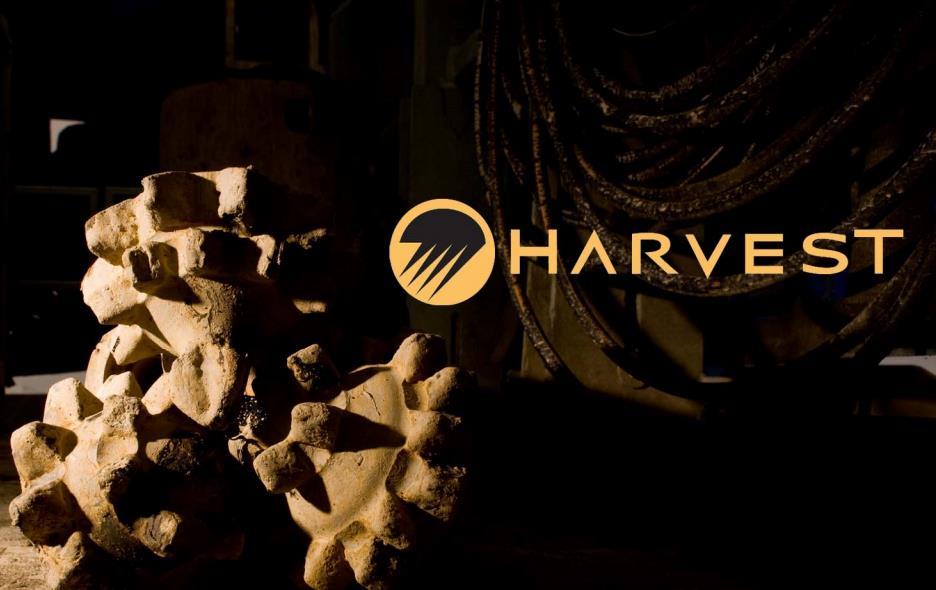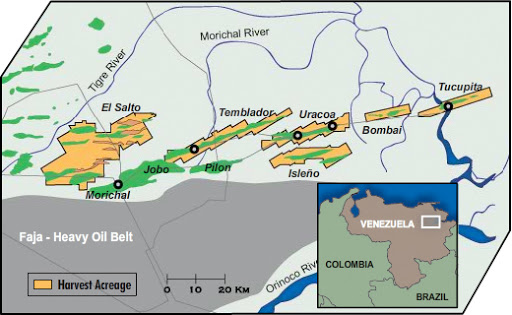
(Harvest Natural Resources, 1.Jan.2014) — Venezuela is the largest province of proved oil reserves in the Western Hemisphere, with 297.6 billion barrels of proved oil reserves at year-end 2011 (the most recent year for which data is available). Petrodelta, our 32% equity affiliate in Venezuela, controls approximately 247,113 gross acres in concessions covering six oil fields. Nearly 90% of the acreage is undeveloped, providing us with significant multi-year development upside from these prolific fields with multiple stacked pay zones.
Petrodelta’s production for 2013 is projected to average approximately 41,300 barrels of oil per day. Capex for 2013 is projected at $210 million gross for drilling 25 oil wells plus associated infrastructure.
Petrodelta has been executing a long-term evaluation and appraisal drilling program in the six fields it operates, focusing on the three new fields awarded to the company. There are five rigs currently operating with a sixth being prepared for operation. The current gross oil production rate is over 41,000 barrels of oil per day (September, 2013).

The nature of the high quality assets in Venezuela supports rapid conversion of unproved resource into proved reserves. At year-end 2012, combined proved and probable (2P) reserves net to Harvest from Petrodelta were 100.2 million barrels of oil equivalent (MMBOE), and combined proved, probable and possible (3P) reserves net to Harvest from Petrodelta were 204.6 MMBOE. Petrodelta’s capital program remains 100% self-funded.
FIELDS
South Monagas Unit (SMU)
Uracoa Field
The Uracoa Field, discovered in 1937, produced 3 million barrels of oil and 1 Bcf of natural gas before it was abandoned in 1987. From 1992 through April 2006, under the terms of an Operating Service Agreement, Harvest produced 93 million barrels of oil and 64 Bcf of natural gas from the field. As of December 31, 2012, the Uracoa field had gross remaining proved reserves of 29 million barrels of oil and 67 Bcf of natural gas, or 7.7 million barrels of oil and 18 Bcf of natural gas net to Harvest’s 32 percent interest after a one-third royalty. The field currently produces about 6,000 BOPD and 7 MMCFD from 77 wells. The Uracoa production facilities have the capacity to handle 60 thousand barrels (MBbls) of oil per day, 130 MBbls of water per day and storage for 40 MBbls of crude oil. Oil from the field is transported by pipeline to the EPT-1 production facility in the Temblador field, where is it delivered to PDVSA.
Tucupita Field
The Tucupita Field, discovered in 1945, produced 67 million barrels of oil before being abandoned in 1987. From 1992 through April 2006, under the terms of an Operating Service Agreement, Harvest produced 18 million barrels of oil from the field. As of December 31, 2012, the Tucupita Field had gross remaining proved reserves of 7.4 million barrels of oil, or 2.0 million barrels of oil net to Harvest’s 32 percent interest after a one-third royalty. The field currently produces about 2,000 BOPD from 19 wells. The production facilities at Tucupita have the capacity to process 30 MBbls of oil per day, 125 MBbls of water per day and storage capacity for 20 MBbls of oil. Oil produced from the Tucupita Field is transported through a 31-mile pipeline, which has capacity for 20 MBbls of oil per day, and delivered to the Uracoa plant facilities.
Bombal Field
The Bombal Field was discovered in 1962 and produced 3 million barrels of oil and 8 Bcf of natural gas before being abandoned in 1987. From 1992 through April 2006, under the terms of an Operating Service Agreement, Harvest produced 2 million barrels of oil and 4 Bcf of natural gas from the field. As of December 31, 2012, the Bombal field had gross remaining proved reserves of 2.6 million barrels of oil, or 0.7 million barrels of oil net to Harvest’s 32 percent interest after a one-third royalty. The field currently produces about 1,000 BOPD from three wells. Oil produced from the Bombal field is combined with Tucupita production and delivered by pipeline to the Uracoa facilities.
The New Fields
The Isleño, Temblador and El Salto fields, transferred to Petrodelta upon conversion in October 2007, are located in the same geographic area and have the same geology and productive formations as the SMU fields. There has been minimal development activity in the three fields during the last 20 years until Petrodelta assumed operatorship in 2008.
Isleño Field
The Isleño field was discovered in 1953 and with the drilling of seven wells has two discovered oil bearing structures with estimated unrisked 3P reserves of 46 million barrels of oil and 3.6 Bcf of natural gas, or 10 million barrels of oil and 0.8 Bcf of natural gas net to Harvest after a one-third royalty. The field is located approximately seven kilometers south of existing infrastructure in the Uracoa field. The first horizontal well, the ILM-8, was drilled by Petrodelta in March 2011 in the north Isleño structure and was tested at a rate of 1,800 BOPD. With this successful test, plans are underway for full field development. A pipeline connection to Uracoa field was completed in 2013 that will allow Isleño to be developed as a satellite to Uracoa. As of December 31, 2012, Isleño had gross proved reserves of 3.0 million barrels of oil, or 0.8 million barrels of oil net to Harvest after a one-third royalty. The field is currently producing about 2,000 BOPD from 2 wells.
Temblador Field
The Temblador field was discovered in 1936 and was partially developed over the next 20 years. Since its discovery and until its transfer to Petrodelta in February 2008, Temblador produced 118 million barrels of oil and 64 billion cubic feet of natural gas from 155 wells. As of December 31, 2012, the Temblador field has estimated proved reserves of 10.2 million barrels of oil and 7 Bcf of natural gas, or 2.7 million barrels of oil and 1.3 Bcf of natural gas net to Harvest after a one-third royalty. The estimated unrisked 3P reserves of the field are 92.6 million barrels of oil and 59 Bcf of natural gas, or 19.8 million barrels of oil and 13 Bcf of natural gas net to Harvest after a one-third royalty. The field currently produces oil from 30 wells. Since its transfer to Petrodelta, the field has increased its production from approximately 1,200 barrels of oil per day to over 10,000 barrels of oil per day in 2011 and is currently producing about 10,000 BOPD. Oil is delivered directly to the EPT-1 production facility.
El Salto Field
The El Salto field was discovered in 1936. Through 2005, a total of 31 wells were drilled that identified nine productive structures and six productive formations but which produced fewer than 1 million barrels of oil and were never developed. As of December 31, 2012, the El Salto field had proved reserves of 110 million barrels of oil and 39 Bcf of natural gas, or 29 million barrels of oil and 9 Bcf of natural gas net to Harvest after a one-third royalty. Total unrisked 3P reserves are 690 million barrels of oil and 185 Bcf of natural gas, or 147 million barrels of oil and 39 Bcf of natural gas net to Harvest after a one-third royalty. Petrodelta began appraisal and development drilling in 2009, and now has 24 wells producing approximately 21,000 BOPD. The oil is currently being transported by pipeline to PDVSA’s Morichal field. Major infrastructure work is planned to allow full development of the El Salto field, including processing plants, tank storage, pipeline and gas and water reinjection facilities. El Salto also has at least 10 undrilled geologic structures identified by seismic which are expected to provide further additions to the total resource in the field.
Reserves
Harvest retained an independent engineering firm to estimate its share of Petrodelta’s reserves as of December 31, 2012. The proved reserve and resource potential estimates were based on a detailed study of the properties. The proved reserves conform to the definition set forth in the Securities and Exchange Commission’s Regulation S-X, as clarified by subsequent Commission Staff Accounting Bulletins. The probable and possible reserves were determined based on Society of Petroleum Engineers and World Petroleum guidelines using deterministic methodology.
Based on the reserve report completed by an independent third party engineering firm, as of December 31, 2012, the six fields held by Petrodelta had proved reserves of 34.5 million barrels of oil (MMBO) and 23.2 billion cubic feet (Bcf) of natural gas net to Harvest’s 32 percent interest after a one-third royalty. The estimated proved plus probable reserves for the fields are 99.5 MMBO and 29.4 Bcf net to Harvest’s 32 percent interest after a one-third royalty.
__________